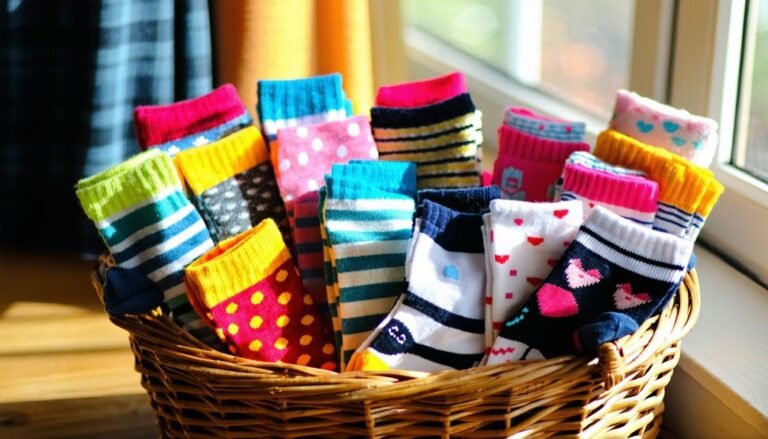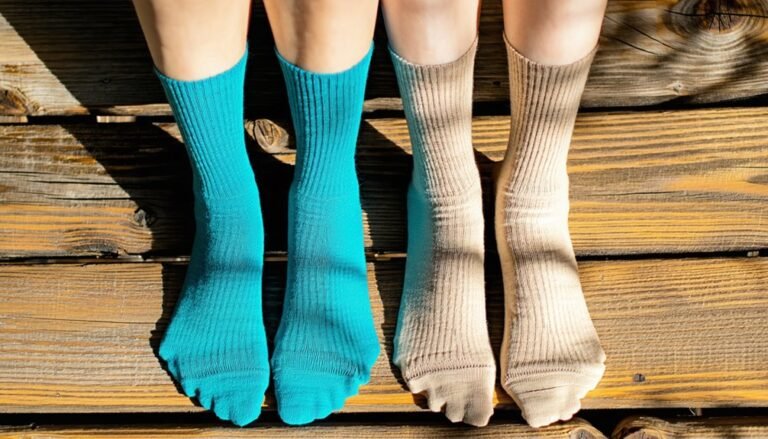Can Sport Socks Get Moldy?
Yes, sport socks can get moldy. Mold thrives in moisture and warmth, deteriorating fabric and posing health risks. Mold can develop after using damp socks or when stored in areas with high humidity. Regular washing and proper drying help avoid this issue. If you notice discoloration or a musty odor, it's likely mold. To minimize risks, guarantee your socks are properly cleaned and stored in well-ventilated spaces. There's more to discover about effective prevention strategies.
Understanding Mold and Its Effects on Fabrics

When it comes to mold, whether or not you encounter it depends largely on environmental conditions such as moisture and warmth. These conditions create a breeding ground for mold, which can severely impact fabric care. Mold prevention is essential, as mold not only deteriorates the material but can also pose health risks. To guarantee safety, maintaining dry and well-ventilated spaces for your sport socks is important. Fabrics exposed to excess moisture are more susceptible to mold growth, so it's significant to dry them thoroughly after washing. Additionally, storing them in a breathable environment helps reduce the risk. Regular inspection of your socks for any signs of mold can prevent extensive damage and maintain their longevity, keeping your feet safe and healthy.
Common Causes of Mold Growth in Sport Socks
Though often overlooked, the primary causes of mold growth in sport socks can be traced to prolonged exposure to moisture and inadequate ventilation. When socks remain damp after use, they create an ideal environment for mold. High humidity levels exacerbate this issue by increasing moisture retention within the fabric fibers. Without proper drying, moisture accumulates, leading to mold proliferation.
It's essential to guarantee your socks dry thoroughly between uses. Storing them in a well-ventilated area reduces the risk of mold development. Utilizing quick-dry materials and moisture-wicking technology can further decrease moisture retention, offering a protective barrier against mold growth. By managing humidity levels and ventilation, you can greatly diminish the potential for mold, guaranteeing a safer, healthier environment for your sport socks.
Signs Your Sport Socks May Be Moldy
How can you tell if your sport socks have fallen victim to mold growth? Mold identification is vital for ensuring a safe environment. First, inspect for discoloration—mold often appears as green, black, or white spots. Next, smell your socks; a musty odor is a strong indicator. Finally, check for texture changes; mold can make fabric feel slimy or brittle.
| Sign | Description |
|---|---|
| Discoloration | Green, black, or white spots |
| Odor | Musty smell |
| Texture Change | Slimy or brittle feel |
Proper sock maintenance is essential to prevent these signs. Regularly wash and thoroughly dry your socks to minimize mold risk. Remember, maintaining cleanliness not only prolongs the life of your socks but also protects your health.
Effective Strategies to Prevent Mold in Sport Socks

To effectively prevent mold growth in sport socks, one must prioritize proper cleaning and storage practices. Selecting the right fabric is essential. Opt for socks made from moisture-wicking materials such as merino wool or synthetic blends, as these fabrics enhance moisture management by drawing sweat away from the skin. This reduces residual dampness, a key factor in mold proliferation.
Further, consider the breathability of the sock material. Fabrics that allow air circulation help keep feet dry, minimizing mold-friendly environments. Regularly inspect your socks for signs of wear, as holes can compromise moisture-wicking capabilities. By choosing high-quality, breathable fabrics and focusing on moisture management, you markedly lower the risk of mold growth, ensuring a safer, healthier environment for your feet.
Proper Cleaning and Storage Techniques for Sport Socks
When aiming to maintain the condition of your sport socks and prevent mold growth, it's crucial to understand the importance of meticulous cleaning and proper storage. Sock washing should be done using hot water and a quality detergent to effectively eliminate bacteria and fungi. Make sure your socks are thoroughly dried before storing them, as moisture is a primary catalyst for mold development. Consider these evidence-based storage solutions:
- Utilize breathable containers to allow air circulation.
- Store in a cool, dry place to minimize humidity exposure.
- Rotate socks regularly to make certain even wear and reduce prolonged storage.
- Avoid plastic bags that can trap moisture.
- Include desiccants to absorb residual moisture.
Adhering to these practices can greatly reduce the risk of mold, making certain your sport socks remain safe and hygienic.
Frequently Asked Questions
Can Mold in Sport Socks Cause Allergic Reactions?
Imagine mold allergies lurking in your socks, a hidden enemy. Poor sock hygiene can indeed lead to mold growth, triggering allergic reactions like sneezing or rashes. Maintaining clean, dry socks is essential for preventing such health risks.
Are Certain Materials More Prone to Developing Mold?
You'll find that cotton socks are more prone to mold than synthetic ones due to higher moisture retention. Cotton absorbs sweat, creating a damp environment ideal for mold growth, whereas synthetics typically offer better moisture-wicking properties.
How Quickly Can Mold Form on Damp Sport Socks?
In a damp environment, mold can form on sport socks faster than you can say "Jack Robinson." Without proper sock storage, mold spores may develop within 24-48 hours, posing health risks. Prioritize airing and drying.
Are There Eco-Friendly Ways to Treat Moldy Sport Socks?
You can treat moldy sport socks with natural remedies like vinegar or baking soda. For preventive measures, guarantee proper drying and storage. Evidence suggests these methods are effective and safe, reducing mold growth without harsh chemicals.
Can Moldy Sport Socks Affect the Smell of Other Clothes?
Imagine your favorite shirt tainted by moldy socks. Yes, smell transfer is real, jeopardizing your laundry hygiene. Prioritize safety by isolating contaminated items to prevent odors from affecting other clothes, ensuring a clean and fresh wardrobe.







